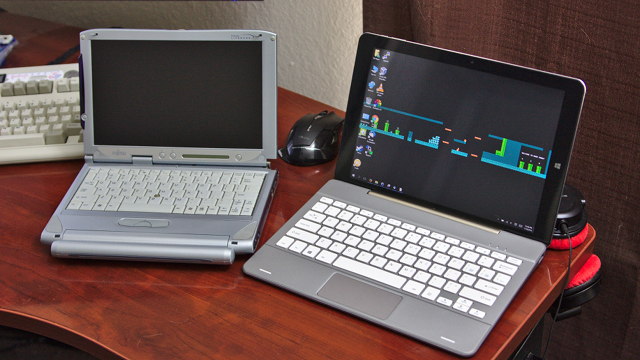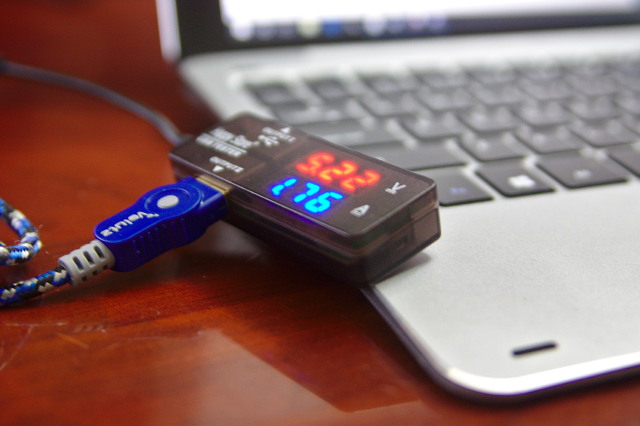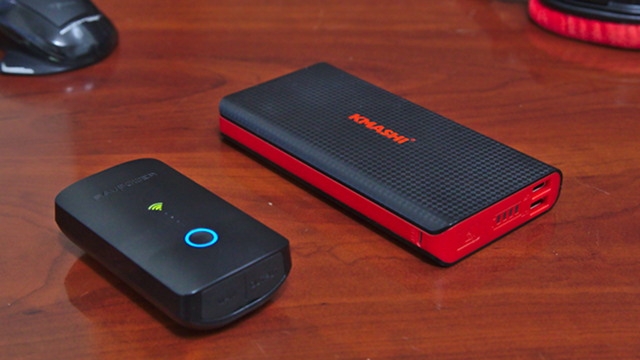In the past, I hadn’t given much thought to the quality of my USB cables. As long as they can pass data and charge my phone overnight, that was all I needed. That changed when I acquired my Chuwi Hi12 tablet. It charges via a Micro-USB port, and the supplied charger provides up to 2.4 amps. This big tablet charges quite slowly, so I wanted to make sure I could get as many milliamps to the tablet as possible.
Thinner wires have higher resistance, and so do longer wires. For convenience, I wanted to pack a 10’ USB cable in my laptop bag to charge my Chuwi Hi12. When I ordered my nylon-wrapped 10’ USB cable, I also dropped a nifty USB ammeter into my cart as well. Truth be told, I expected most of the USB cables in my home office to have similar performance.

Had this been the case, though, I wouldn’t have bothered writing this blog post. I was surprised by my initial findings. Some of my thicker, more expensive cables ended up being poor performers. In fact, they performed worse than some of my thin, generic cables—a thick jacket doesn’t always mean there’s thicker gauge wire inside!
- Chuwi Hi12 Tablet at Gearbest.com
tl;dr
Buy Volutz nylon braided cables. They are high-quality cables, they look great, and Volutz cables are very reasonably priced!
- Volutz Micro-USB Variety Pack at Amazon
- Volutz 10-foot Micro-USB cable at Amazon
- Volutz Micro-USB 6-foot 5 Pack at Amazon
The Volutz cables seem to be in short supply at Amazon. The Anker PowerLine cables charge my devices slightly faster than the Volutz cables, and their Kevlar wrapping sounds interesting. I just wish they came in 10’ lengths!
- Anker PowerLine Micro-USB 5-pack at Amazon
Testing methodology
I tried to be as scientific as possible. When your device has less charge, it will draw more amperage. I used my Chuwi Hi12 because it is the most power-hungry device I own that charges using a Micro-USB port. I started with the Chuwi Hi12 at about 75% charge—low enough to draw a lot of current, while high enough that I didn’t have to wait all day for the battery to drain.

I tested each cable with four different chargers and one USB battery pack. I didn’t need to test this many different chargers. I definitely wanted to compare a high-amperage charger against a more common 1A charger. My intuition says that even a crummy USB cable will work fine if the current is low enough, but my curiosity got the better of me—I wanted to know if I was carrying the optimal charging adapter in my laptop bag!
- Digital USB Power Meter at Amazon
Enough with the jibber-jabber! Lets see those numbers!
| Chuwi 3A | Ravpower 2.4A | Omaker 2.4A | Fire TV 1.2A | Kmashi Battery | |
|---|---|---|---|---|---|
| Kmashi 6” | 1.29 | 1.83 | 1.81 | 1.17 | 0.86 |
| Aukey 3’ | 1.68 | 1.28 | 1.27 | 0.97 | 0.73 |
| Omaker 3’ | 1.52 | 1.23 | 1.16 | 0.95 | 0.69 |
| Volutz 3’ | 2.09 | 1.76 | 1.85 | 1.17 | 0.85 |
| Anker Kevlar 3’ | 1.83 | 1.83 | —— | —— | 0.71 |
| Ravpower 3’ | 1.86 | 1.44 | 1.4 | 0.4(?) | 0.76 |
| Anker Kevlar 6’ | 1.83 | 1.59 | —— | —— | 0.71 |
| Volutz 6’ | 1.98 | 1.54 | 1.52 | 1.17 | 0.74 |
| Ravpower 10’ | 1.29 | 1.03 | 0.97 | 0.84 | 0.6 |
| Volutz 10’ | 1.77 | 1.47 | 1.42 | 1.15 | 0.73 |
NOTE: The Anker cables are a late addition to the chart. I tried to replicate my test conditions as closely as possible, but I’ve misplaced two of the chargers, and all the cables I retested today scored 0.05+ amps lower than last time. I don’t know what’s to blame, but the differences are less than 5%.
The Volutz cables that I chose actually ended up being quite good! In fact, I only have one non-Volutz cable that works better than my ridiculously long 10’ Volutz cable, and it is only 3’ long!
The first cable I ordered specifically for my Chuwi Hi12 was a single Volutz 10’ Micro-USB cable—the one with the fancy blue nylon covering. My USB ammeter said it was pretty good cable, so I ordered more Volutz cables. This time it was the 5-pack of assorted cables in 3’, 6’ and 10’ lengths.

Aside from the Volutz cables, I also tested cables that I’ve been accruing over the years. My RAVPower Micro-USB cables came in an assortment of similar lengths, and the Aukey cables came in an assorted set of 3’ and 1’ lengths. I included the Omaker and Kmashi cables in the table, because they came with two of the charging devices I used in my testing.
- Volutz Micro-USB Variety Pack at Amazon
- Volutz 10-foot Micro-USB cable at Amazon
- Volutz Micro-USB 6-foot 5 Pack at Amazon
Anker’s Kevlar cables (added 2017-01-22)
I’ve been using the Volutz cables for three months, and I’m quite pleased with them. The micro-USB ends still feel like new, and I have nothing to complain about. I saw a deal on a 5-pack of Anker PowerLine Micro-USB cables a few days ago, and I just had to try them out!
They look and feel exactly like ordinary USB cables. At first glance, you’d most likely mistake them for some of the thicker generic USB cables I tested. Whereas those cheap cables are mostly rubber, these nice Anker cables are mostly copper! In fact, Anker upgraded the 5-volt line in these cables to 20-gauge wire.
I tested all the other cables three months ago, and I’m not entirely convinced that I replicated the test perfectly. I retested the Volutz 6’ cable for comparison, and I’m getting about 0.06 fewer amps out of it this time around. I have quite a few Volutz 6’ cables floating around, so I may have tested a different cable last time. The guy running the tests is most likely to blame for any inconsistencies. Today’s results are within about 5%, so I’m not too worried.
On my chart, the Anker PowerLine cables scored almost as well as my Volutz cables. In today’s tests, my Volutz 6’ cable didn’t do quite as well as the Anker PowerLine 6’ cable—the Volutz cable came in about 0.06 amps lower than the last time I tested.
The Anker PowerLine cables are probably the better cable. I just wish Anker sold a 10’ version to match my Volutz 10’ Micro-USB cable!
- Anker PowerLine Micro-USB 5-pack at Amazon
The data on the chargers is interesting
The big, clunky power supply that came with my Chuwi Hi12 provides almost 20% more amperage than either of my 2.4A power supplies. Unfortunately, it is a Chinese charger with an adapter for American wall sockets. It works fine hiding on the floor next to my recliner, but it is too clunky and fiddly to use away from home.
One of the first things I bought for the Chuwi was a RAVPower charger with a pair of 2.4A ports for about $10. It is compact, and it works great. About a week after it arrived, there was a deal at Amazon on some Omaker brand 2.4A chargers. A two-pack of Omaker chargers was $8.99. I couldn’t pass them up at that price.

Instead of two identical 2.4A charging ports like the RAVPower unit, the Omaker charger has one 2.4A port and one “quick-charge” port. The “quick-charge” port can provide 9V or 12V to certain devices. If you don’t have any devices that can take advantage of the “quick-charge” port, I’d go with the RAVPower unit—it is more compact and charges ordinary 5V devices a bit faster.
- RAVPower Dual 2.4A USB Charger at Amazon
- Omaker Dual Port USB QuickCharge at Amazon
Conclusion
If you need to charge your power-hungry USB devices quickly, or you need a long cable, I can’t recommend the Volutz USB cables highly enough. They’re high-quality USB cables with sturdy connectors, and they charge my devices at least 30% faster than my next best cable when using a 2.4A charger. The difference is almost as wide using a 1.2A charger. My Android phone will only draw about 1A, and my 10’ Volutz cables can charge my phone 20% faster than any of my 3’ cables.
I am a fan of the nylon braiding of the Volutz cables. The braiding looks cool, and the cables don’t tangle as easily, because the braiding keeps the cable stiff.
- Anker PowerLine Micro-USB 5-pack at Amazon
- Volutz Micro-USB Variety Pack at Amazon
- Volutz 10-foot Micro-USB cable at Amazon
- Volutz Micro-USB 6-foot 5 Pack at Amazon